Report on Developing Individuals, Teams, and Organisations-Unit 35
VerifiedAdded on 2023/06/04
|14
|4183
|333
Report
AI Summary
This report delves into the multifaceted aspects of developing individuals, teams, and organizations, emphasizing the critical role of HR professionals in maximizing workforce efficiency and productivity. It highlights the essential skills required for HR professionals, including business management, human capital development, communication, strategic thinking, and workplace culture development, further analyzing personal skills through a SWOT analysis and a personal development plan. The report distinguishes between organizational and individual learning, as well as training and development, underscoring the need for continuous learning and professional development to maintain organizational growth and competitive advantage. It also explores the contribution of High-Performance Work practices (HPW) to employee engagement and competitive advantage, different approaches to performance management, and their impact on fostering a high-performance culture and commitment within the organization.
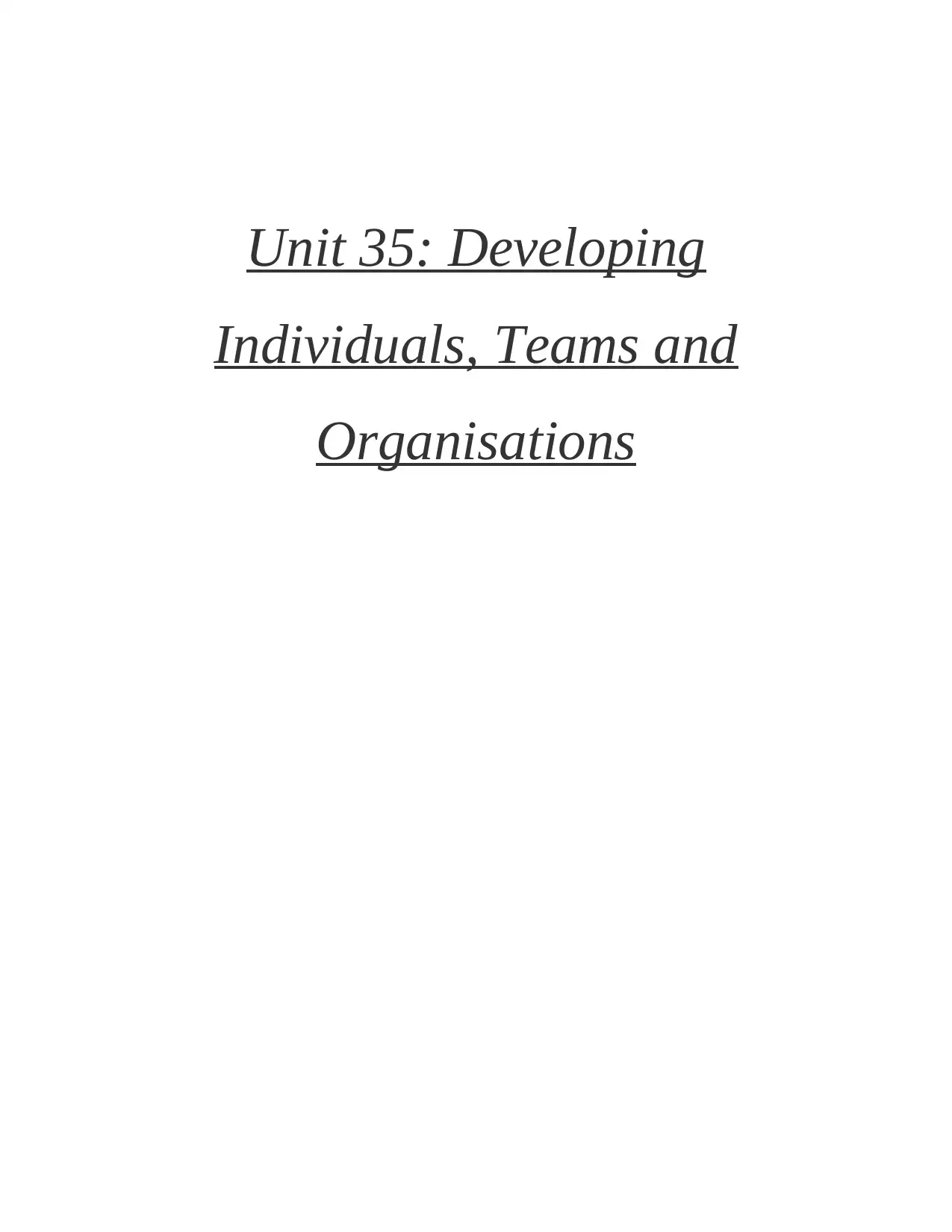
Unit 35: Developing
Individuals, Teams and
Organisations
Individuals, Teams and
Organisations
Paraphrase This Document
Need a fresh take? Get an instant paraphrase of this document with our AI Paraphraser
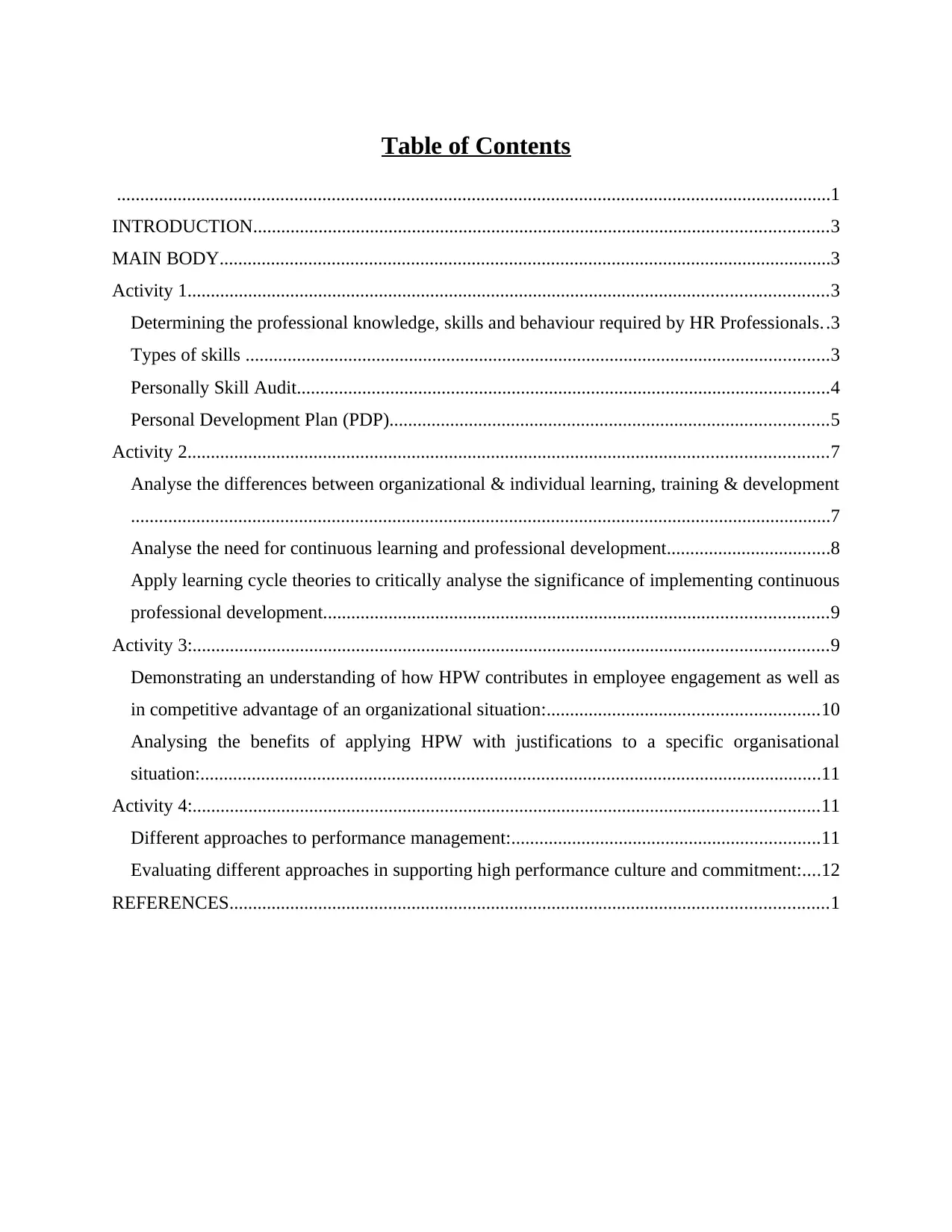
Table of Contents
.........................................................................................................................................................1
INTRODUCTION...........................................................................................................................3
MAIN BODY...................................................................................................................................3
Activity 1.........................................................................................................................................3
Determining the professional knowledge, skills and behaviour required by HR Professionals..3
Types of skills .............................................................................................................................3
Personally Skill Audit..................................................................................................................4
Personal Development Plan (PDP)..............................................................................................5
Activity 2.........................................................................................................................................7
Analyse the differences between organizational & individual learning, training & development
......................................................................................................................................................7
Analyse the need for continuous learning and professional development...................................8
Apply learning cycle theories to critically analyse the significance of implementing continuous
professional development............................................................................................................9
Activity 3:........................................................................................................................................9
Demonstrating an understanding of how HPW contributes in employee engagement as well as
in competitive advantage of an organizational situation:..........................................................10
Analysing the benefits of applying HPW with justifications to a specific organisational
situation:.....................................................................................................................................11
Activity 4:......................................................................................................................................11
Different approaches to performance management:..................................................................11
Evaluating different approaches in supporting high performance culture and commitment:....12
REFERENCES................................................................................................................................1
.........................................................................................................................................................1
INTRODUCTION...........................................................................................................................3
MAIN BODY...................................................................................................................................3
Activity 1.........................................................................................................................................3
Determining the professional knowledge, skills and behaviour required by HR Professionals..3
Types of skills .............................................................................................................................3
Personally Skill Audit..................................................................................................................4
Personal Development Plan (PDP)..............................................................................................5
Activity 2.........................................................................................................................................7
Analyse the differences between organizational & individual learning, training & development
......................................................................................................................................................7
Analyse the need for continuous learning and professional development...................................8
Apply learning cycle theories to critically analyse the significance of implementing continuous
professional development............................................................................................................9
Activity 3:........................................................................................................................................9
Demonstrating an understanding of how HPW contributes in employee engagement as well as
in competitive advantage of an organizational situation:..........................................................10
Analysing the benefits of applying HPW with justifications to a specific organisational
situation:.....................................................................................................................................11
Activity 4:......................................................................................................................................11
Different approaches to performance management:..................................................................11
Evaluating different approaches in supporting high performance culture and commitment:....12
REFERENCES................................................................................................................................1
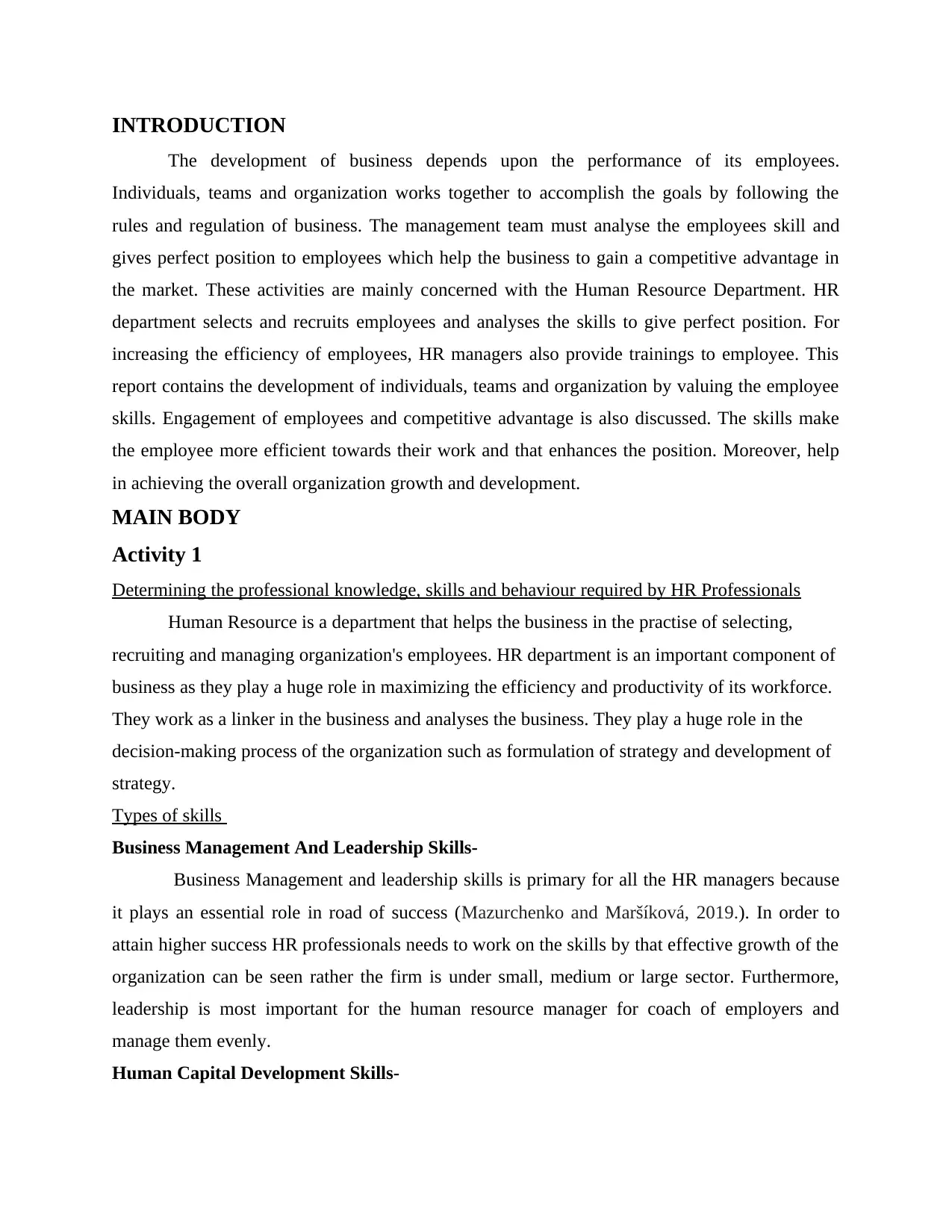
INTRODUCTION
The development of business depends upon the performance of its employees.
Individuals, teams and organization works together to accomplish the goals by following the
rules and regulation of business. The management team must analyse the employees skill and
gives perfect position to employees which help the business to gain a competitive advantage in
the market. These activities are mainly concerned with the Human Resource Department. HR
department selects and recruits employees and analyses the skills to give perfect position. For
increasing the efficiency of employees, HR managers also provide trainings to employee. This
report contains the development of individuals, teams and organization by valuing the employee
skills. Engagement of employees and competitive advantage is also discussed. The skills make
the employee more efficient towards their work and that enhances the position. Moreover, help
in achieving the overall organization growth and development.
MAIN BODY
Activity 1
Determining the professional knowledge, skills and behaviour required by HR Professionals
Human Resource is a department that helps the business in the practise of selecting,
recruiting and managing organization's employees. HR department is an important component of
business as they play a huge role in maximizing the efficiency and productivity of its workforce.
They work as a linker in the business and analyses the business. They play a huge role in the
decision-making process of the organization such as formulation of strategy and development of
strategy.
Types of skills
Business Management And Leadership Skills-
Business Management and leadership skills is primary for all the HR managers because
it plays an essential role in road of success (Mazurchenko and Maršíková, 2019.). In order to
attain higher success HR professionals needs to work on the skills by that effective growth of the
organization can be seen rather the firm is under small, medium or large sector. Furthermore,
leadership is most important for the human resource manager for coach of employers and
manage them evenly.
Human Capital Development Skills-
The development of business depends upon the performance of its employees.
Individuals, teams and organization works together to accomplish the goals by following the
rules and regulation of business. The management team must analyse the employees skill and
gives perfect position to employees which help the business to gain a competitive advantage in
the market. These activities are mainly concerned with the Human Resource Department. HR
department selects and recruits employees and analyses the skills to give perfect position. For
increasing the efficiency of employees, HR managers also provide trainings to employee. This
report contains the development of individuals, teams and organization by valuing the employee
skills. Engagement of employees and competitive advantage is also discussed. The skills make
the employee more efficient towards their work and that enhances the position. Moreover, help
in achieving the overall organization growth and development.
MAIN BODY
Activity 1
Determining the professional knowledge, skills and behaviour required by HR Professionals
Human Resource is a department that helps the business in the practise of selecting,
recruiting and managing organization's employees. HR department is an important component of
business as they play a huge role in maximizing the efficiency and productivity of its workforce.
They work as a linker in the business and analyses the business. They play a huge role in the
decision-making process of the organization such as formulation of strategy and development of
strategy.
Types of skills
Business Management And Leadership Skills-
Business Management and leadership skills is primary for all the HR managers because
it plays an essential role in road of success (Mazurchenko and Maršíková, 2019.). In order to
attain higher success HR professionals needs to work on the skills by that effective growth of the
organization can be seen rather the firm is under small, medium or large sector. Furthermore,
leadership is most important for the human resource manager for coach of employers and
manage them evenly.
Human Capital Development Skills-
⊘ This is a preview!⊘
Do you want full access?
Subscribe today to unlock all pages.

Trusted by 1+ million students worldwide
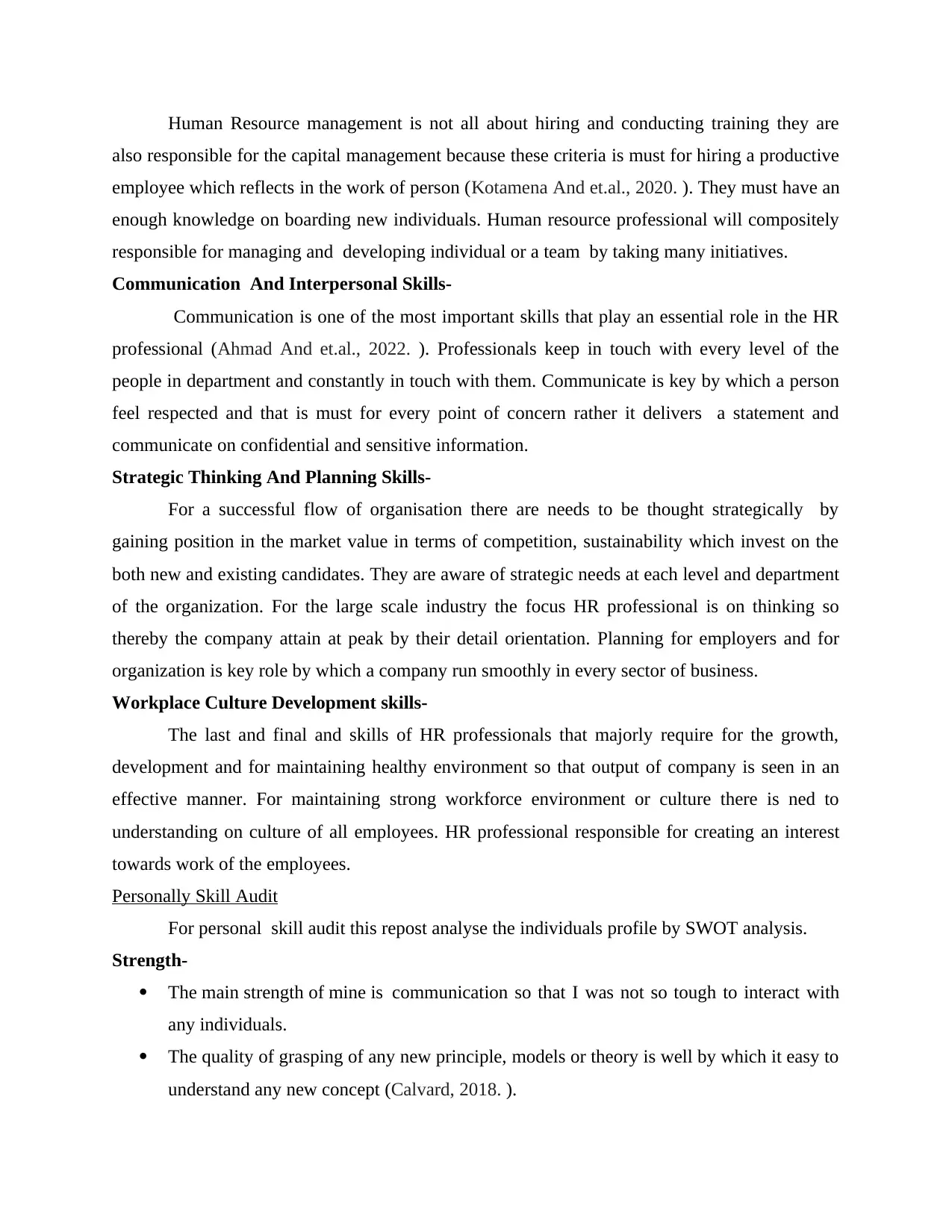
Human Resource management is not all about hiring and conducting training they are
also responsible for the capital management because these criteria is must for hiring a productive
employee which reflects in the work of person (Kotamena And et.al., 2020. ). They must have an
enough knowledge on boarding new individuals. Human resource professional will compositely
responsible for managing and developing individual or a team by taking many initiatives.
Communication And Interpersonal Skills-
Communication is one of the most important skills that play an essential role in the HR
professional (Ahmad And et.al., 2022. ). Professionals keep in touch with every level of the
people in department and constantly in touch with them. Communicate is key by which a person
feel respected and that is must for every point of concern rather it delivers a statement and
communicate on confidential and sensitive information.
Strategic Thinking And Planning Skills-
For a successful flow of organisation there are needs to be thought strategically by
gaining position in the market value in terms of competition, sustainability which invest on the
both new and existing candidates. They are aware of strategic needs at each level and department
of the organization. For the large scale industry the focus HR professional is on thinking so
thereby the company attain at peak by their detail orientation. Planning for employers and for
organization is key role by which a company run smoothly in every sector of business.
Workplace Culture Development skills-
The last and final and skills of HR professionals that majorly require for the growth,
development and for maintaining healthy environment so that output of company is seen in an
effective manner. For maintaining strong workforce environment or culture there is ned to
understanding on culture of all employees. HR professional responsible for creating an interest
towards work of the employees.
Personally Skill Audit
For personal skill audit this repost analyse the individuals profile by SWOT analysis.
Strength-
The main strength of mine is communication so that I was not so tough to interact with
any individuals.
The quality of grasping of any new principle, models or theory is well by which it easy to
understand any new concept (Calvard, 2018. ).
also responsible for the capital management because these criteria is must for hiring a productive
employee which reflects in the work of person (Kotamena And et.al., 2020. ). They must have an
enough knowledge on boarding new individuals. Human resource professional will compositely
responsible for managing and developing individual or a team by taking many initiatives.
Communication And Interpersonal Skills-
Communication is one of the most important skills that play an essential role in the HR
professional (Ahmad And et.al., 2022. ). Professionals keep in touch with every level of the
people in department and constantly in touch with them. Communicate is key by which a person
feel respected and that is must for every point of concern rather it delivers a statement and
communicate on confidential and sensitive information.
Strategic Thinking And Planning Skills-
For a successful flow of organisation there are needs to be thought strategically by
gaining position in the market value in terms of competition, sustainability which invest on the
both new and existing candidates. They are aware of strategic needs at each level and department
of the organization. For the large scale industry the focus HR professional is on thinking so
thereby the company attain at peak by their detail orientation. Planning for employers and for
organization is key role by which a company run smoothly in every sector of business.
Workplace Culture Development skills-
The last and final and skills of HR professionals that majorly require for the growth,
development and for maintaining healthy environment so that output of company is seen in an
effective manner. For maintaining strong workforce environment or culture there is ned to
understanding on culture of all employees. HR professional responsible for creating an interest
towards work of the employees.
Personally Skill Audit
For personal skill audit this repost analyse the individuals profile by SWOT analysis.
Strength-
The main strength of mine is communication so that I was not so tough to interact with
any individuals.
The quality of grasping of any new principle, models or theory is well by which it easy to
understand any new concept (Calvard, 2018. ).
Paraphrase This Document
Need a fresh take? Get an instant paraphrase of this document with our AI Paraphraser
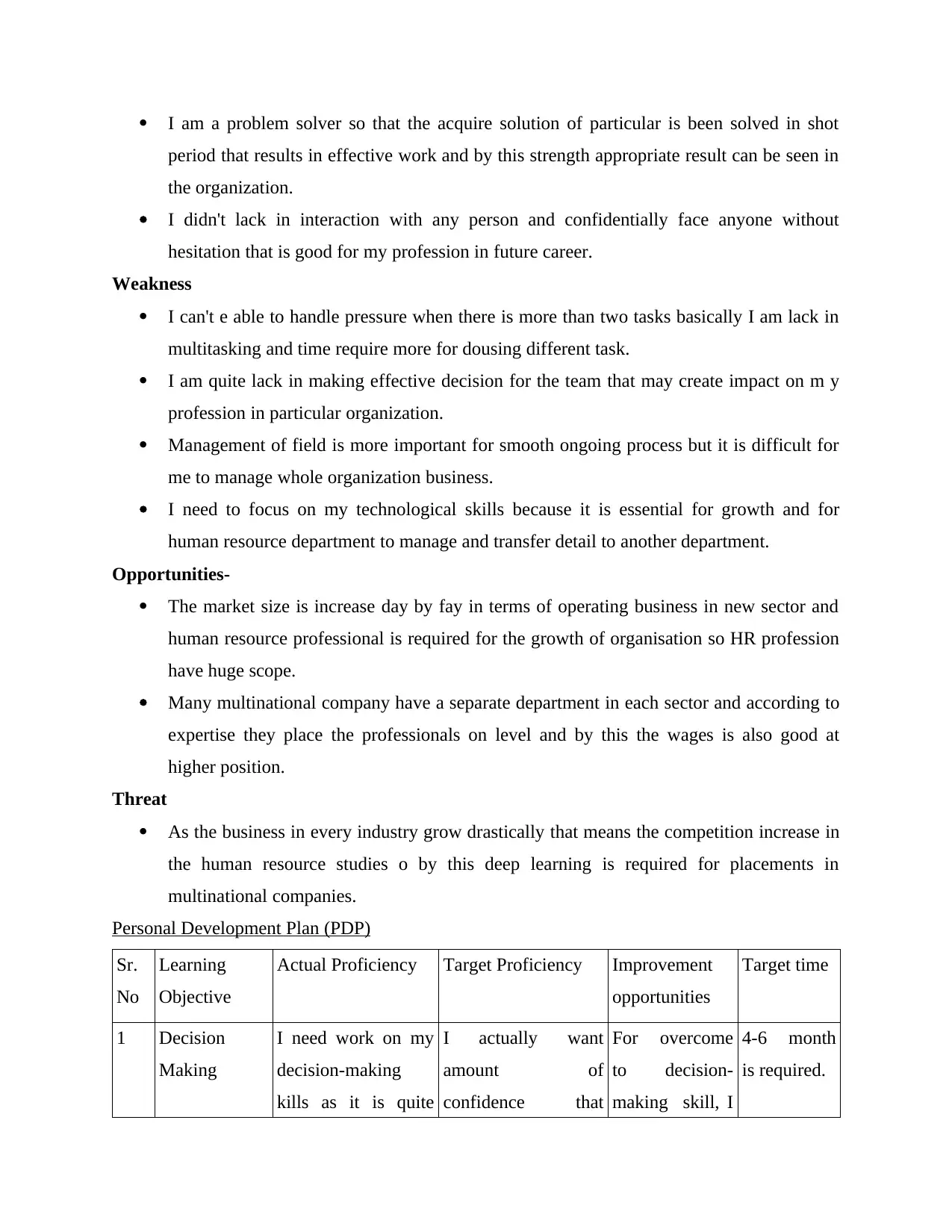
I am a problem solver so that the acquire solution of particular is been solved in shot
period that results in effective work and by this strength appropriate result can be seen in
the organization.
I didn't lack in interaction with any person and confidentially face anyone without
hesitation that is good for my profession in future career.
Weakness
I can't e able to handle pressure when there is more than two tasks basically I am lack in
multitasking and time require more for dousing different task.
I am quite lack in making effective decision for the team that may create impact on m y
profession in particular organization.
Management of field is more important for smooth ongoing process but it is difficult for
me to manage whole organization business.
I need to focus on my technological skills because it is essential for growth and for
human resource department to manage and transfer detail to another department.
Opportunities-
The market size is increase day by fay in terms of operating business in new sector and
human resource professional is required for the growth of organisation so HR profession
have huge scope.
Many multinational company have a separate department in each sector and according to
expertise they place the professionals on level and by this the wages is also good at
higher position.
Threat
As the business in every industry grow drastically that means the competition increase in
the human resource studies o by this deep learning is required for placements in
multinational companies.
Personal Development Plan (PDP)
Sr.
No
Learning
Objective
Actual Proficiency Target Proficiency Improvement
opportunities
Target time
1 Decision
Making
I need work on my
decision-making
kills as it is quite
I actually want
amount of
confidence that
For overcome
to decision-
making skill, I
4-6 month
is required.
period that results in effective work and by this strength appropriate result can be seen in
the organization.
I didn't lack in interaction with any person and confidentially face anyone without
hesitation that is good for my profession in future career.
Weakness
I can't e able to handle pressure when there is more than two tasks basically I am lack in
multitasking and time require more for dousing different task.
I am quite lack in making effective decision for the team that may create impact on m y
profession in particular organization.
Management of field is more important for smooth ongoing process but it is difficult for
me to manage whole organization business.
I need to focus on my technological skills because it is essential for growth and for
human resource department to manage and transfer detail to another department.
Opportunities-
The market size is increase day by fay in terms of operating business in new sector and
human resource professional is required for the growth of organisation so HR profession
have huge scope.
Many multinational company have a separate department in each sector and according to
expertise they place the professionals on level and by this the wages is also good at
higher position.
Threat
As the business in every industry grow drastically that means the competition increase in
the human resource studies o by this deep learning is required for placements in
multinational companies.
Personal Development Plan (PDP)
Sr.
No
Learning
Objective
Actual Proficiency Target Proficiency Improvement
opportunities
Target time
1 Decision
Making
I need work on my
decision-making
kills as it is quite
I actually want
amount of
confidence that
For overcome
to decision-
making skill, I
4-6 month
is required.
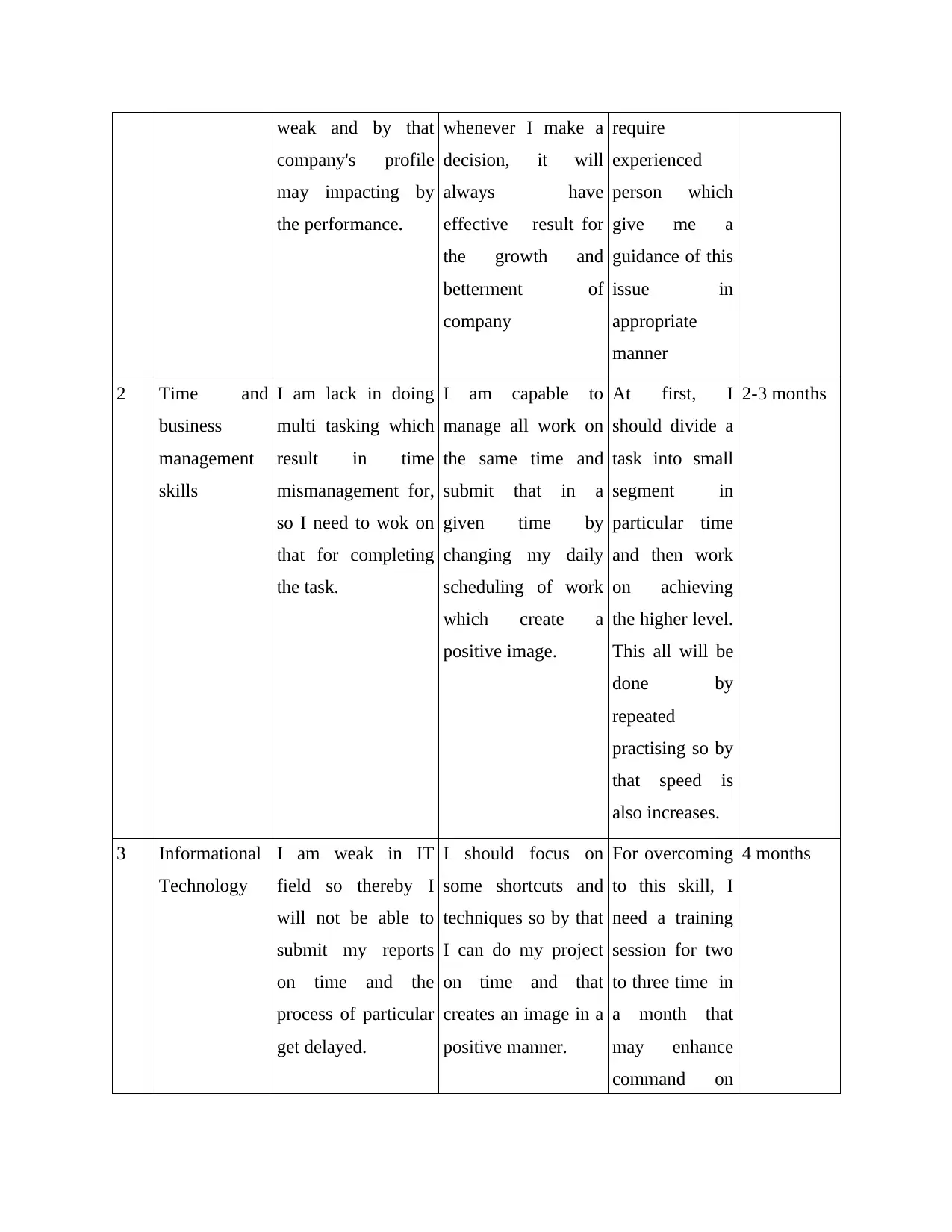
weak and by that
company's profile
may impacting by
the performance.
whenever I make a
decision, it will
always have
effective result for
the growth and
betterment of
company
require
experienced
person which
give me a
guidance of this
issue in
appropriate
manner
2 Time and
business
management
skills
I am lack in doing
multi tasking which
result in time
mismanagement for,
so I need to wok on
that for completing
the task.
I am capable to
manage all work on
the same time and
submit that in a
given time by
changing my daily
scheduling of work
which create a
positive image.
At first, I
should divide a
task into small
segment in
particular time
and then work
on achieving
the higher level.
This all will be
done by
repeated
practising so by
that speed is
also increases.
2-3 months
3 Informational
Technology
I am weak in IT
field so thereby I
will not be able to
submit my reports
on time and the
process of particular
get delayed.
I should focus on
some shortcuts and
techniques so by that
I can do my project
on time and that
creates an image in a
positive manner.
For overcoming
to this skill, I
need a training
session for two
to three time in
a month that
may enhance
command on
4 months
company's profile
may impacting by
the performance.
whenever I make a
decision, it will
always have
effective result for
the growth and
betterment of
company
require
experienced
person which
give me a
guidance of this
issue in
appropriate
manner
2 Time and
business
management
skills
I am lack in doing
multi tasking which
result in time
mismanagement for,
so I need to wok on
that for completing
the task.
I am capable to
manage all work on
the same time and
submit that in a
given time by
changing my daily
scheduling of work
which create a
positive image.
At first, I
should divide a
task into small
segment in
particular time
and then work
on achieving
the higher level.
This all will be
done by
repeated
practising so by
that speed is
also increases.
2-3 months
3 Informational
Technology
I am weak in IT
field so thereby I
will not be able to
submit my reports
on time and the
process of particular
get delayed.
I should focus on
some shortcuts and
techniques so by that
I can do my project
on time and that
creates an image in a
positive manner.
For overcoming
to this skill, I
need a training
session for two
to three time in
a month that
may enhance
command on
4 months
⊘ This is a preview!⊘
Do you want full access?
Subscribe today to unlock all pages.

Trusted by 1+ million students worldwide
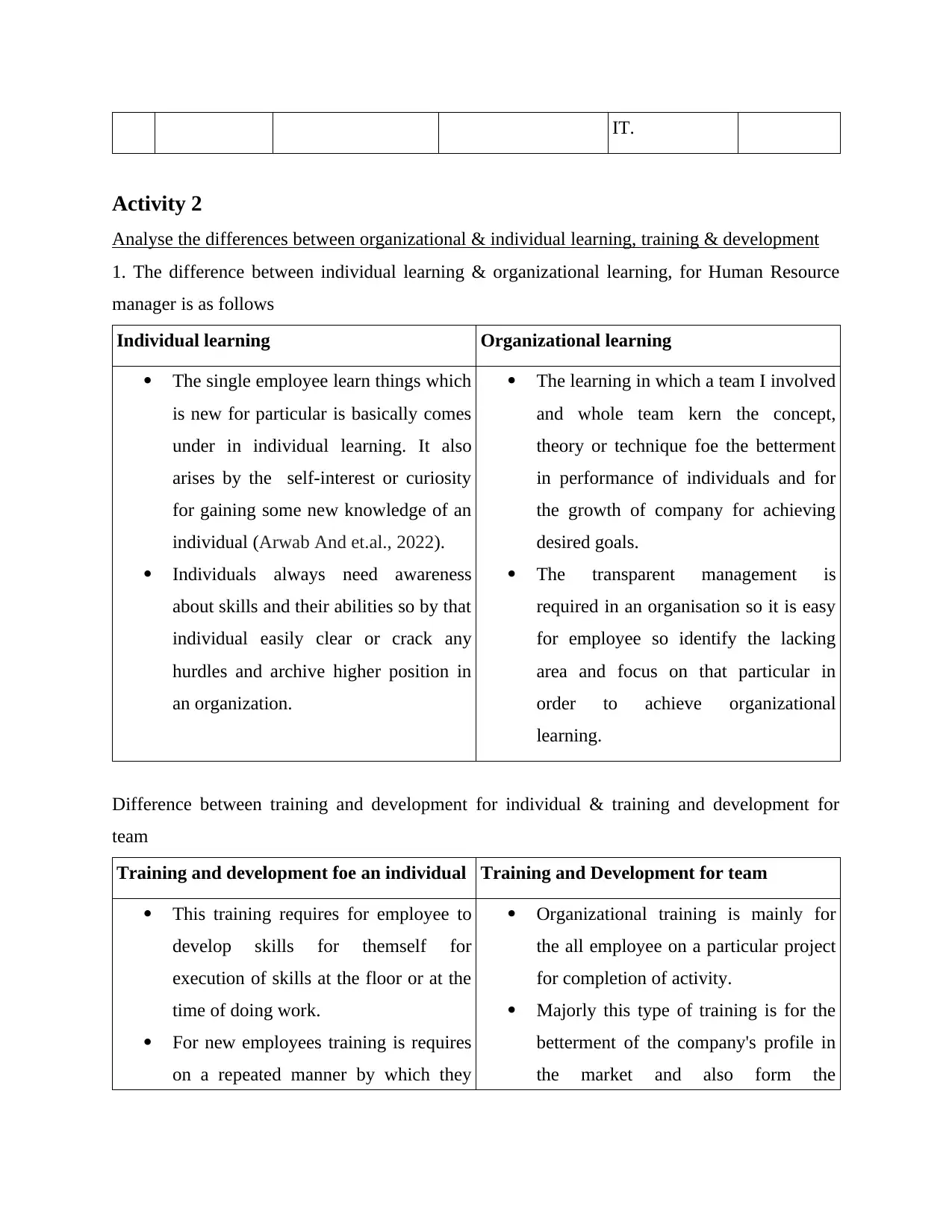
IT.
Activity 2
Analyse the differences between organizational & individual learning, training & development
1. The difference between individual learning & organizational learning, for Human Resource
manager is as follows
Individual learning Organizational learning
The single employee learn things which
is new for particular is basically comes
under in individual learning. It also
arises by the self-interest or curiosity
for gaining some new knowledge of an
individual (Arwab And et.al., 2022).
Individuals always need awareness
about skills and their abilities so by that
individual easily clear or crack any
hurdles and archive higher position in
an organization.
The learning in which a team I involved
and whole team kern the concept,
theory or technique foe the betterment
in performance of individuals and for
the growth of company for achieving
desired goals.
The transparent management is
required in an organisation so it is easy
for employee so identify the lacking
area and focus on that particular in
order to achieve organizational
learning.
Difference between training and development for individual & training and development for
team
Training and development foe an individual Training and Development for team
This training requires for employee to
develop skills for themself for
execution of skills at the floor or at the
time of doing work.
For new employees training is requires
on a repeated manner by which they
Organizational training is mainly for
the all employee on a particular project
for completion of activity.
Majorly this type of training is for the
betterment of the company's profile in
the market and also form the
Activity 2
Analyse the differences between organizational & individual learning, training & development
1. The difference between individual learning & organizational learning, for Human Resource
manager is as follows
Individual learning Organizational learning
The single employee learn things which
is new for particular is basically comes
under in individual learning. It also
arises by the self-interest or curiosity
for gaining some new knowledge of an
individual (Arwab And et.al., 2022).
Individuals always need awareness
about skills and their abilities so by that
individual easily clear or crack any
hurdles and archive higher position in
an organization.
The learning in which a team I involved
and whole team kern the concept,
theory or technique foe the betterment
in performance of individuals and for
the growth of company for achieving
desired goals.
The transparent management is
required in an organisation so it is easy
for employee so identify the lacking
area and focus on that particular in
order to achieve organizational
learning.
Difference between training and development for individual & training and development for
team
Training and development foe an individual Training and Development for team
This training requires for employee to
develop skills for themself for
execution of skills at the floor or at the
time of doing work.
For new employees training is requires
on a repeated manner by which they
Organizational training is mainly for
the all employee on a particular project
for completion of activity.
Majorly this type of training is for the
betterment of the company's profile in
the market and also form the
Paraphrase This Document
Need a fresh take? Get an instant paraphrase of this document with our AI Paraphraser
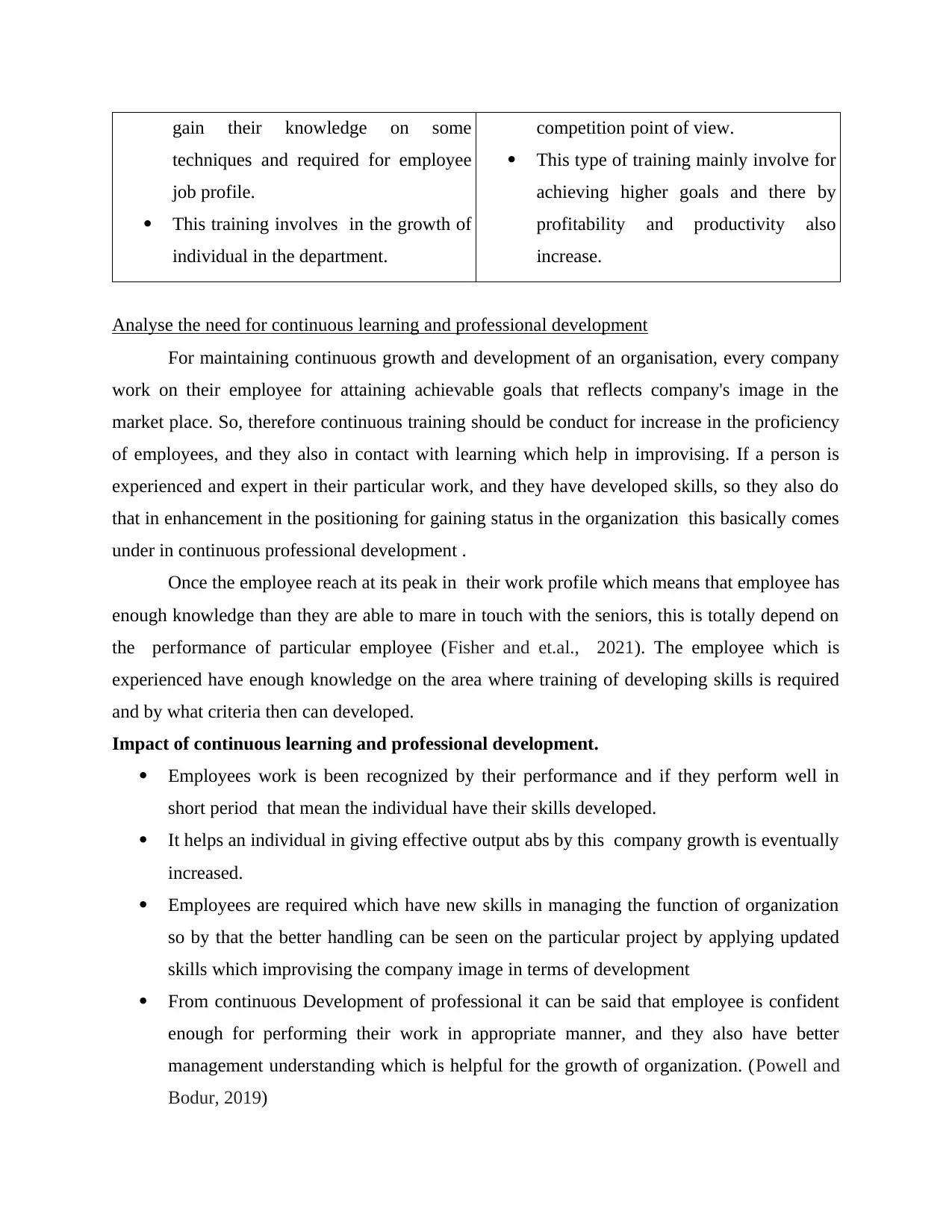
gain their knowledge on some
techniques and required for employee
job profile.
This training involves in the growth of
individual in the department.
competition point of view.
This type of training mainly involve for
achieving higher goals and there by
profitability and productivity also
increase.
Analyse the need for continuous learning and professional development
For maintaining continuous growth and development of an organisation, every company
work on their employee for attaining achievable goals that reflects company's image in the
market place. So, therefore continuous training should be conduct for increase in the proficiency
of employees, and they also in contact with learning which help in improvising. If a person is
experienced and expert in their particular work, and they have developed skills, so they also do
that in enhancement in the positioning for gaining status in the organization this basically comes
under in continuous professional development .
Once the employee reach at its peak in their work profile which means that employee has
enough knowledge than they are able to mare in touch with the seniors, this is totally depend on
the performance of particular employee (Fisher and et.al., 2021). The employee which is
experienced have enough knowledge on the area where training of developing skills is required
and by what criteria then can developed.
Impact of continuous learning and professional development.
Employees work is been recognized by their performance and if they perform well in
short period that mean the individual have their skills developed.
It helps an individual in giving effective output abs by this company growth is eventually
increased.
Employees are required which have new skills in managing the function of organization
so by that the better handling can be seen on the particular project by applying updated
skills which improvising the company image in terms of development
From continuous Development of professional it can be said that employee is confident
enough for performing their work in appropriate manner, and they also have better
management understanding which is helpful for the growth of organization. (Powell and
Bodur, 2019)
techniques and required for employee
job profile.
This training involves in the growth of
individual in the department.
competition point of view.
This type of training mainly involve for
achieving higher goals and there by
profitability and productivity also
increase.
Analyse the need for continuous learning and professional development
For maintaining continuous growth and development of an organisation, every company
work on their employee for attaining achievable goals that reflects company's image in the
market place. So, therefore continuous training should be conduct for increase in the proficiency
of employees, and they also in contact with learning which help in improvising. If a person is
experienced and expert in their particular work, and they have developed skills, so they also do
that in enhancement in the positioning for gaining status in the organization this basically comes
under in continuous professional development .
Once the employee reach at its peak in their work profile which means that employee has
enough knowledge than they are able to mare in touch with the seniors, this is totally depend on
the performance of particular employee (Fisher and et.al., 2021). The employee which is
experienced have enough knowledge on the area where training of developing skills is required
and by what criteria then can developed.
Impact of continuous learning and professional development.
Employees work is been recognized by their performance and if they perform well in
short period that mean the individual have their skills developed.
It helps an individual in giving effective output abs by this company growth is eventually
increased.
Employees are required which have new skills in managing the function of organization
so by that the better handling can be seen on the particular project by applying updated
skills which improvising the company image in terms of development
From continuous Development of professional it can be said that employee is confident
enough for performing their work in appropriate manner, and they also have better
management understanding which is helpful for the growth of organization. (Powell and
Bodur, 2019)
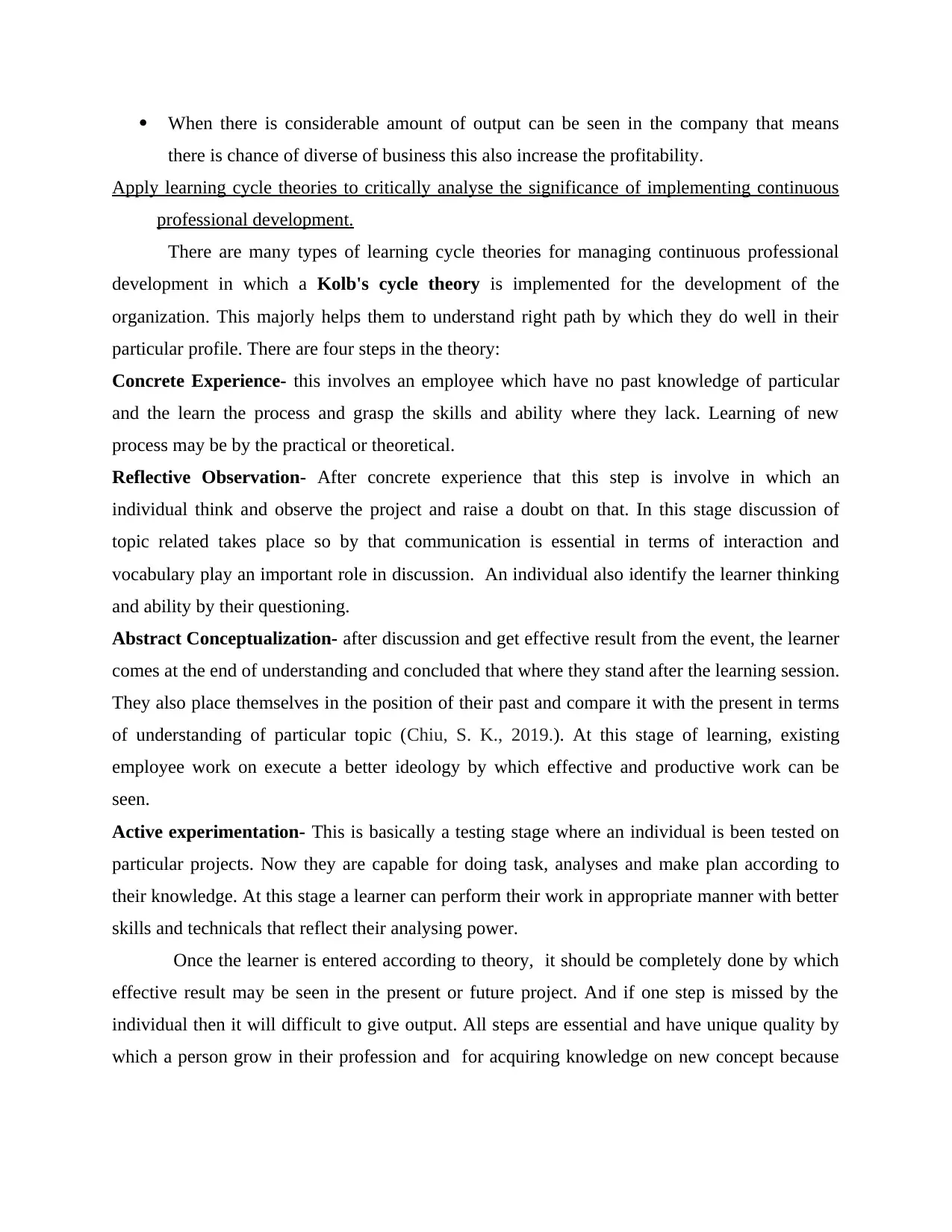
When there is considerable amount of output can be seen in the company that means
there is chance of diverse of business this also increase the profitability.
Apply learning cycle theories to critically analyse the significance of implementing continuous
professional development.
There are many types of learning cycle theories for managing continuous professional
development in which a Kolb's cycle theory is implemented for the development of the
organization. This majorly helps them to understand right path by which they do well in their
particular profile. There are four steps in the theory:
Concrete Experience- this involves an employee which have no past knowledge of particular
and the learn the process and grasp the skills and ability where they lack. Learning of new
process may be by the practical or theoretical.
Reflective Observation- After concrete experience that this step is involve in which an
individual think and observe the project and raise a doubt on that. In this stage discussion of
topic related takes place so by that communication is essential in terms of interaction and
vocabulary play an important role in discussion. An individual also identify the learner thinking
and ability by their questioning.
Abstract Conceptualization- after discussion and get effective result from the event, the learner
comes at the end of understanding and concluded that where they stand after the learning session.
They also place themselves in the position of their past and compare it with the present in terms
of understanding of particular topic (Chiu, S. K., 2019.). At this stage of learning, existing
employee work on execute a better ideology by which effective and productive work can be
seen.
Active experimentation- This is basically a testing stage where an individual is been tested on
particular projects. Now they are capable for doing task, analyses and make plan according to
their knowledge. At this stage a learner can perform their work in appropriate manner with better
skills and technicals that reflect their analysing power.
Once the learner is entered according to theory, it should be completely done by which
effective result may be seen in the present or future project. And if one step is missed by the
individual then it will difficult to give output. All steps are essential and have unique quality by
which a person grow in their profession and for acquiring knowledge on new concept because
there is chance of diverse of business this also increase the profitability.
Apply learning cycle theories to critically analyse the significance of implementing continuous
professional development.
There are many types of learning cycle theories for managing continuous professional
development in which a Kolb's cycle theory is implemented for the development of the
organization. This majorly helps them to understand right path by which they do well in their
particular profile. There are four steps in the theory:
Concrete Experience- this involves an employee which have no past knowledge of particular
and the learn the process and grasp the skills and ability where they lack. Learning of new
process may be by the practical or theoretical.
Reflective Observation- After concrete experience that this step is involve in which an
individual think and observe the project and raise a doubt on that. In this stage discussion of
topic related takes place so by that communication is essential in terms of interaction and
vocabulary play an important role in discussion. An individual also identify the learner thinking
and ability by their questioning.
Abstract Conceptualization- after discussion and get effective result from the event, the learner
comes at the end of understanding and concluded that where they stand after the learning session.
They also place themselves in the position of their past and compare it with the present in terms
of understanding of particular topic (Chiu, S. K., 2019.). At this stage of learning, existing
employee work on execute a better ideology by which effective and productive work can be
seen.
Active experimentation- This is basically a testing stage where an individual is been tested on
particular projects. Now they are capable for doing task, analyses and make plan according to
their knowledge. At this stage a learner can perform their work in appropriate manner with better
skills and technicals that reflect their analysing power.
Once the learner is entered according to theory, it should be completely done by which
effective result may be seen in the present or future project. And if one step is missed by the
individual then it will difficult to give output. All steps are essential and have unique quality by
which a person grow in their profession and for acquiring knowledge on new concept because
⊘ This is a preview!⊘
Do you want full access?
Subscribe today to unlock all pages.

Trusted by 1+ million students worldwide
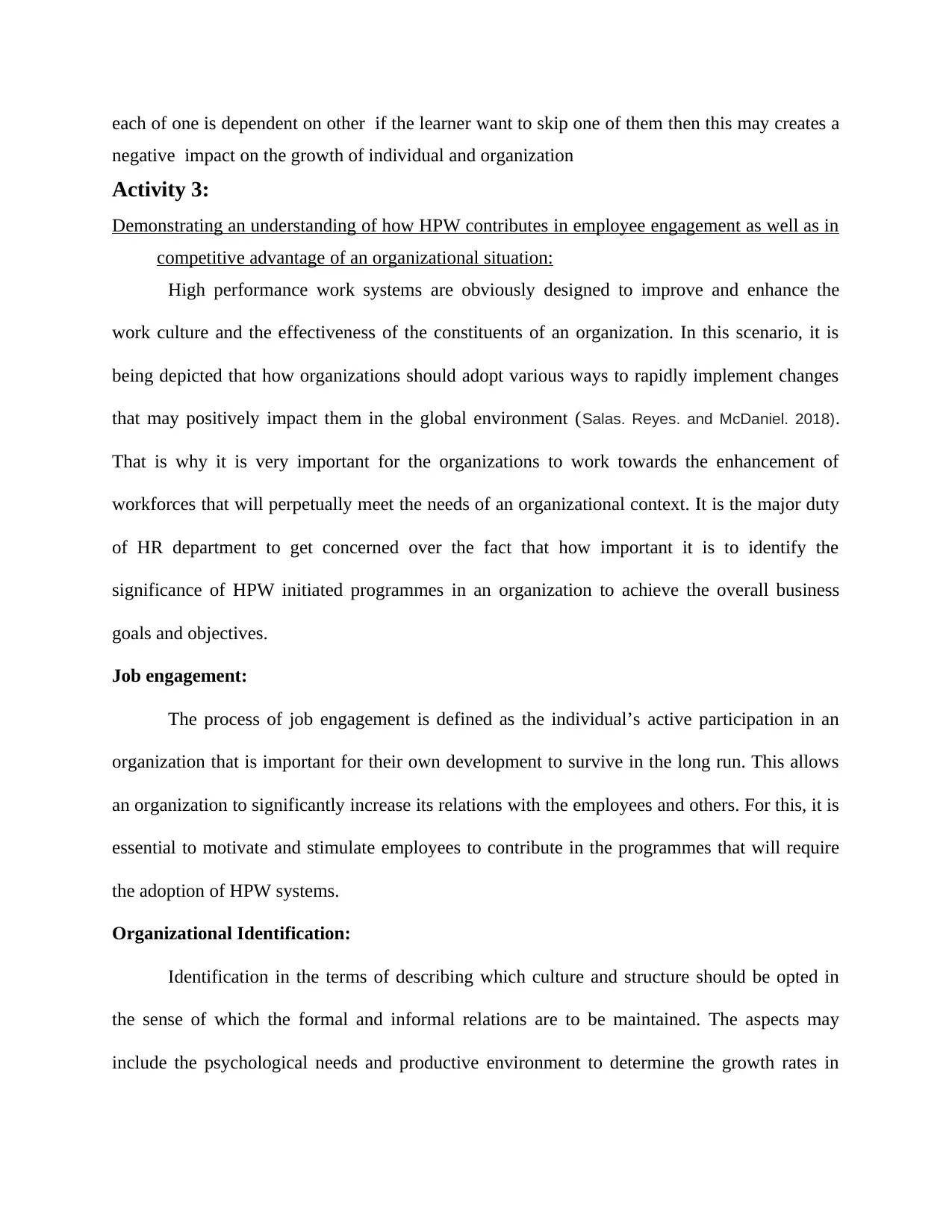
each of one is dependent on other if the learner want to skip one of them then this may creates a
negative impact on the growth of individual and organization
Activity 3:
Demonstrating an understanding of how HPW contributes in employee engagement as well as in
competitive advantage of an organizational situation:
High performance work systems are obviously designed to improve and enhance the
work culture and the effectiveness of the constituents of an organization. In this scenario, it is
being depicted that how organizations should adopt various ways to rapidly implement changes
that may positively impact them in the global environment (Salas. Reyes. and McDaniel. 2018).
That is why it is very important for the organizations to work towards the enhancement of
workforces that will perpetually meet the needs of an organizational context. It is the major duty
of HR department to get concerned over the fact that how important it is to identify the
significance of HPW initiated programmes in an organization to achieve the overall business
goals and objectives.
Job engagement:
The process of job engagement is defined as the individual’s active participation in an
organization that is important for their own development to survive in the long run. This allows
an organization to significantly increase its relations with the employees and others. For this, it is
essential to motivate and stimulate employees to contribute in the programmes that will require
the adoption of HPW systems.
Organizational Identification:
Identification in the terms of describing which culture and structure should be opted in
the sense of which the formal and informal relations are to be maintained. The aspects may
include the psychological needs and productive environment to determine the growth rates in
negative impact on the growth of individual and organization
Activity 3:
Demonstrating an understanding of how HPW contributes in employee engagement as well as in
competitive advantage of an organizational situation:
High performance work systems are obviously designed to improve and enhance the
work culture and the effectiveness of the constituents of an organization. In this scenario, it is
being depicted that how organizations should adopt various ways to rapidly implement changes
that may positively impact them in the global environment (Salas. Reyes. and McDaniel. 2018).
That is why it is very important for the organizations to work towards the enhancement of
workforces that will perpetually meet the needs of an organizational context. It is the major duty
of HR department to get concerned over the fact that how important it is to identify the
significance of HPW initiated programmes in an organization to achieve the overall business
goals and objectives.
Job engagement:
The process of job engagement is defined as the individual’s active participation in an
organization that is important for their own development to survive in the long run. This allows
an organization to significantly increase its relations with the employees and others. For this, it is
essential to motivate and stimulate employees to contribute in the programmes that will require
the adoption of HPW systems.
Organizational Identification:
Identification in the terms of describing which culture and structure should be opted in
the sense of which the formal and informal relations are to be maintained. The aspects may
include the psychological needs and productive environment to determine the growth rates in
Paraphrase This Document
Need a fresh take? Get an instant paraphrase of this document with our AI Paraphraser
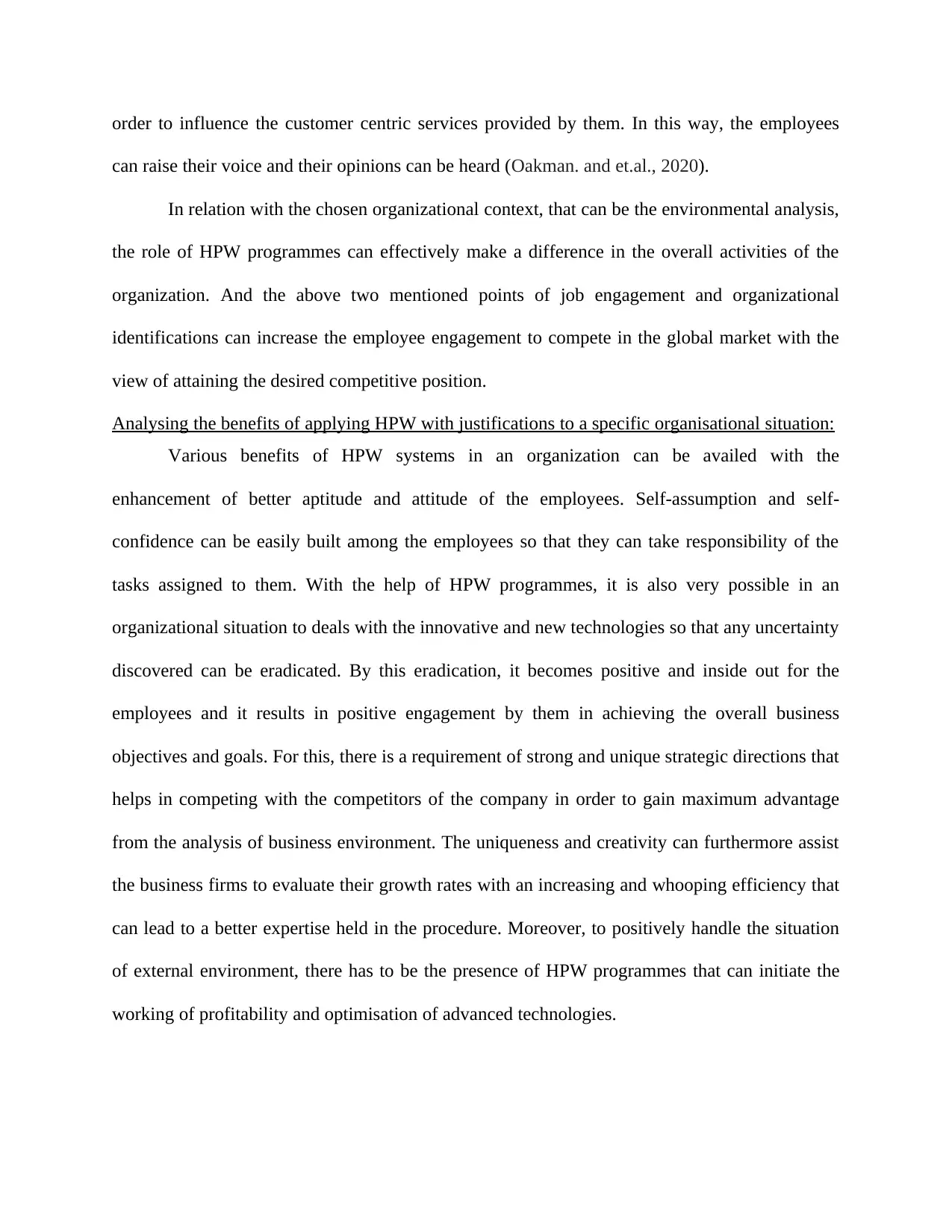
order to influence the customer centric services provided by them. In this way, the employees
can raise their voice and their opinions can be heard (Oakman. and et.al., 2020).
In relation with the chosen organizational context, that can be the environmental analysis,
the role of HPW programmes can effectively make a difference in the overall activities of the
organization. And the above two mentioned points of job engagement and organizational
identifications can increase the employee engagement to compete in the global market with the
view of attaining the desired competitive position.
Analysing the benefits of applying HPW with justifications to a specific organisational situation:
Various benefits of HPW systems in an organization can be availed with the
enhancement of better aptitude and attitude of the employees. Self-assumption and self-
confidence can be easily built among the employees so that they can take responsibility of the
tasks assigned to them. With the help of HPW programmes, it is also very possible in an
organizational situation to deals with the innovative and new technologies so that any uncertainty
discovered can be eradicated. By this eradication, it becomes positive and inside out for the
employees and it results in positive engagement by them in achieving the overall business
objectives and goals. For this, there is a requirement of strong and unique strategic directions that
helps in competing with the competitors of the company in order to gain maximum advantage
from the analysis of business environment. The uniqueness and creativity can furthermore assist
the business firms to evaluate their growth rates with an increasing and whooping efficiency that
can lead to a better expertise held in the procedure. Moreover, to positively handle the situation
of external environment, there has to be the presence of HPW programmes that can initiate the
working of profitability and optimisation of advanced technologies.
can raise their voice and their opinions can be heard (Oakman. and et.al., 2020).
In relation with the chosen organizational context, that can be the environmental analysis,
the role of HPW programmes can effectively make a difference in the overall activities of the
organization. And the above two mentioned points of job engagement and organizational
identifications can increase the employee engagement to compete in the global market with the
view of attaining the desired competitive position.
Analysing the benefits of applying HPW with justifications to a specific organisational situation:
Various benefits of HPW systems in an organization can be availed with the
enhancement of better aptitude and attitude of the employees. Self-assumption and self-
confidence can be easily built among the employees so that they can take responsibility of the
tasks assigned to them. With the help of HPW programmes, it is also very possible in an
organizational situation to deals with the innovative and new technologies so that any uncertainty
discovered can be eradicated. By this eradication, it becomes positive and inside out for the
employees and it results in positive engagement by them in achieving the overall business
objectives and goals. For this, there is a requirement of strong and unique strategic directions that
helps in competing with the competitors of the company in order to gain maximum advantage
from the analysis of business environment. The uniqueness and creativity can furthermore assist
the business firms to evaluate their growth rates with an increasing and whooping efficiency that
can lead to a better expertise held in the procedure. Moreover, to positively handle the situation
of external environment, there has to be the presence of HPW programmes that can initiate the
working of profitability and optimisation of advanced technologies.
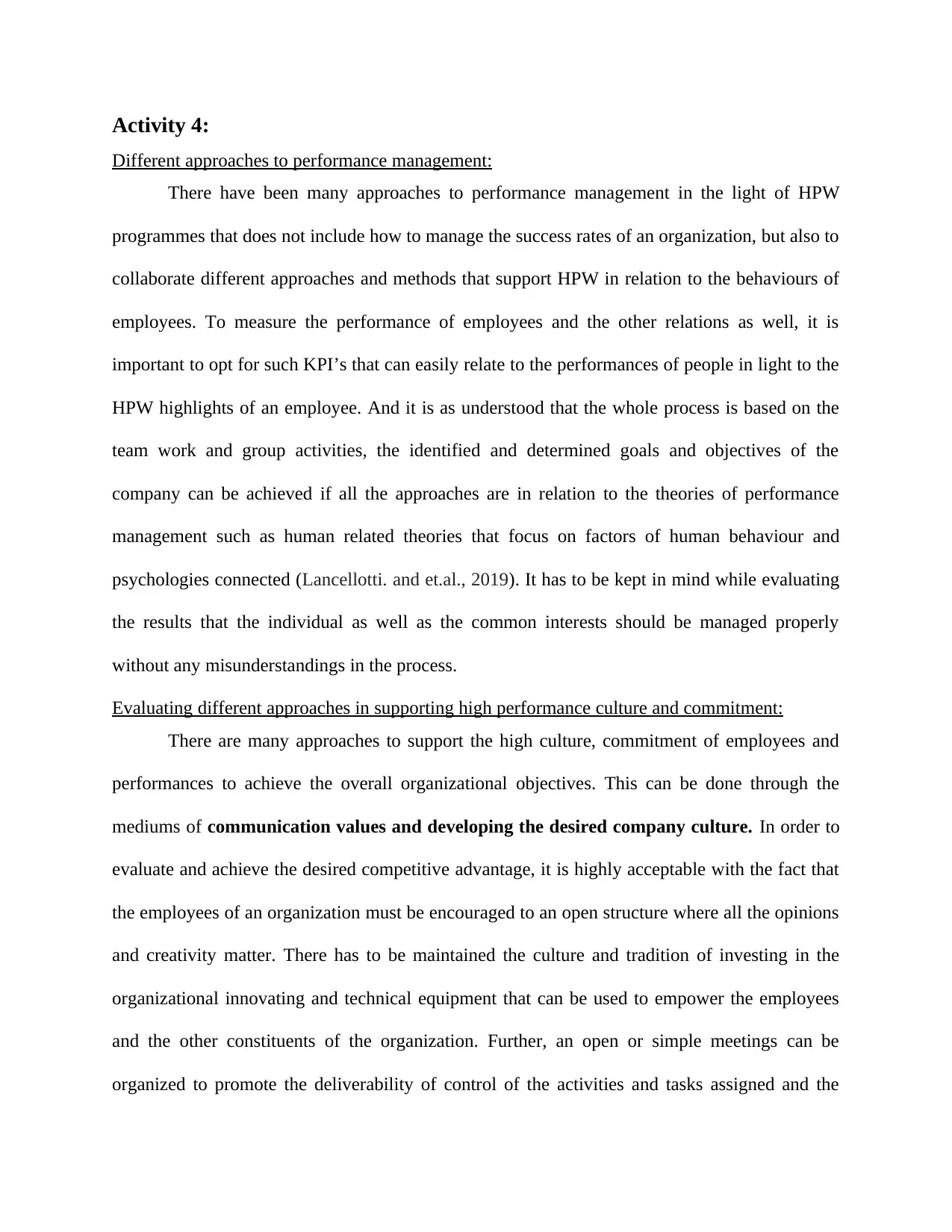
Activity 4:
Different approaches to performance management:
There have been many approaches to performance management in the light of HPW
programmes that does not include how to manage the success rates of an organization, but also to
collaborate different approaches and methods that support HPW in relation to the behaviours of
employees. To measure the performance of employees and the other relations as well, it is
important to opt for such KPI’s that can easily relate to the performances of people in light to the
HPW highlights of an employee. And it is as understood that the whole process is based on the
team work and group activities, the identified and determined goals and objectives of the
company can be achieved if all the approaches are in relation to the theories of performance
management such as human related theories that focus on factors of human behaviour and
psychologies connected (Lancellotti. and et.al., 2019). It has to be kept in mind while evaluating
the results that the individual as well as the common interests should be managed properly
without any misunderstandings in the process.
Evaluating different approaches in supporting high performance culture and commitment:
There are many approaches to support the high culture, commitment of employees and
performances to achieve the overall organizational objectives. This can be done through the
mediums of communication values and developing the desired company culture. In order to
evaluate and achieve the desired competitive advantage, it is highly acceptable with the fact that
the employees of an organization must be encouraged to an open structure where all the opinions
and creativity matter. There has to be maintained the culture and tradition of investing in the
organizational innovating and technical equipment that can be used to empower the employees
and the other constituents of the organization. Further, an open or simple meetings can be
organized to promote the deliverability of control of the activities and tasks assigned and the
Different approaches to performance management:
There have been many approaches to performance management in the light of HPW
programmes that does not include how to manage the success rates of an organization, but also to
collaborate different approaches and methods that support HPW in relation to the behaviours of
employees. To measure the performance of employees and the other relations as well, it is
important to opt for such KPI’s that can easily relate to the performances of people in light to the
HPW highlights of an employee. And it is as understood that the whole process is based on the
team work and group activities, the identified and determined goals and objectives of the
company can be achieved if all the approaches are in relation to the theories of performance
management such as human related theories that focus on factors of human behaviour and
psychologies connected (Lancellotti. and et.al., 2019). It has to be kept in mind while evaluating
the results that the individual as well as the common interests should be managed properly
without any misunderstandings in the process.
Evaluating different approaches in supporting high performance culture and commitment:
There are many approaches to support the high culture, commitment of employees and
performances to achieve the overall organizational objectives. This can be done through the
mediums of communication values and developing the desired company culture. In order to
evaluate and achieve the desired competitive advantage, it is highly acceptable with the fact that
the employees of an organization must be encouraged to an open structure where all the opinions
and creativity matter. There has to be maintained the culture and tradition of investing in the
organizational innovating and technical equipment that can be used to empower the employees
and the other constituents of the organization. Further, an open or simple meetings can be
organized to promote the deliverability of control of the activities and tasks assigned and the
⊘ This is a preview!⊘
Do you want full access?
Subscribe today to unlock all pages.

Trusted by 1+ million students worldwide
1 out of 14
Related Documents
Your All-in-One AI-Powered Toolkit for Academic Success.
+13062052269
info@desklib.com
Available 24*7 on WhatsApp / Email
![[object Object]](/_next/static/media/star-bottom.7253800d.svg)
Unlock your academic potential
Copyright © 2020–2025 A2Z Services. All Rights Reserved. Developed and managed by ZUCOL.


